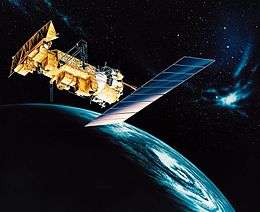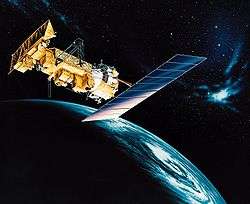NOAA-15
 Artist's impression of NOAA-15 in orbit | |
| Mission type | Weather satellite |
|---|---|
| Operator | NOAA |
| COSPAR ID | 1998-030A |
| SATCAT № | 25338 |
| Mission duration | 2 years[1] |
| Spacecraft properties | |
| Spacecraft type | TIROS-N |
| Manufacturer | Lockheed Martin |
| Launch mass | 1,457 kilograms (3,212 lb)[2] |
| Power | 830 watts[3] |
| Start of mission | |
| Launch date | 13 May 1998, 15:52:04 UTC[4] |
| Rocket | Titan II(23)G Star-37XFP-ISS |
| Launch site | Vandenberg SLC-4W |
| Orbital parameters | |
| Reference system | Geocentric |
| Regime | Sun-synchronous |
| Semi-major axis | 7,184.62 kilometers (4,464.32 mi)[5] |
| Eccentricity | 0.001007[5] |
| Perigee | 806 kilometers (501 mi)[5] |
| Apogee | 820 kilometers (510 mi)[5] |
| Inclination | 98.77 degrees[5] |
| Period | 101.01 minutes[5] |
| Epoch | 24 January 2015, 13:51:02 UTC[5] |
NOAA-15 (designated NOAA-K before launch) is one of the NASA-provided TIROS series of weather forecasting satellite run by NOAA. It was launched on 13 May 1998, and is currently operational, in a sun-synchronous orbit, 807 km above the Earth, orbiting every 101 minutes. It hosts the AMSU-A and AMSU-B instruments, the AVHRR and High Resolution Infrared Radiation Sounder (HIRS/3) instruments, as well as a Space Environment Monitor (SEM/2).[6]
APT transmission frequency is 137.62 MHz. Due to problems with the S-band transmitter high-gain antennas, NOAA-15 has been configured for High Resolution Picture Transmission using the S-Band Transmitter #2 (1702.5 MHz) omnidirectional antenna.[7]
References
- ↑ Krebs, Gunter. "NOAA 15, 16, 17 (NOAA K, L, M)". Gunter's Space Page. Retrieved 8 December 2013.
- ↑ "NOAA 15". National Space Science Data Center. Retrieved 8 December 2013.
- ↑ "UCS Satellite Database". Union of Concerned Scientists. Retrieved 8 December 2013.
- ↑ McDowell, Jonathan. "Launch Log". Jonathan's Space Page. Retrieved 8 December 2013.
- 1 2 3 4 5 6 7 "NOAA 15 Satellite details 1998-030A NORAD 25338". N2YO. 24 January 2015. Retrieved 25 January 2015.
- ↑ "NOAA-N Prime" (PDF). NP-2008-10-056-GSFC. NASA Goddard Space Flight Center. 16 December 2008. Retrieved 8 October 2010.
- ↑ NOAA 15 Spacecraft Status Summary
This article is issued from Wikipedia - version of the 6/5/2015. The text is available under the Creative Commons Attribution/Share Alike but additional terms may apply for the media files.
